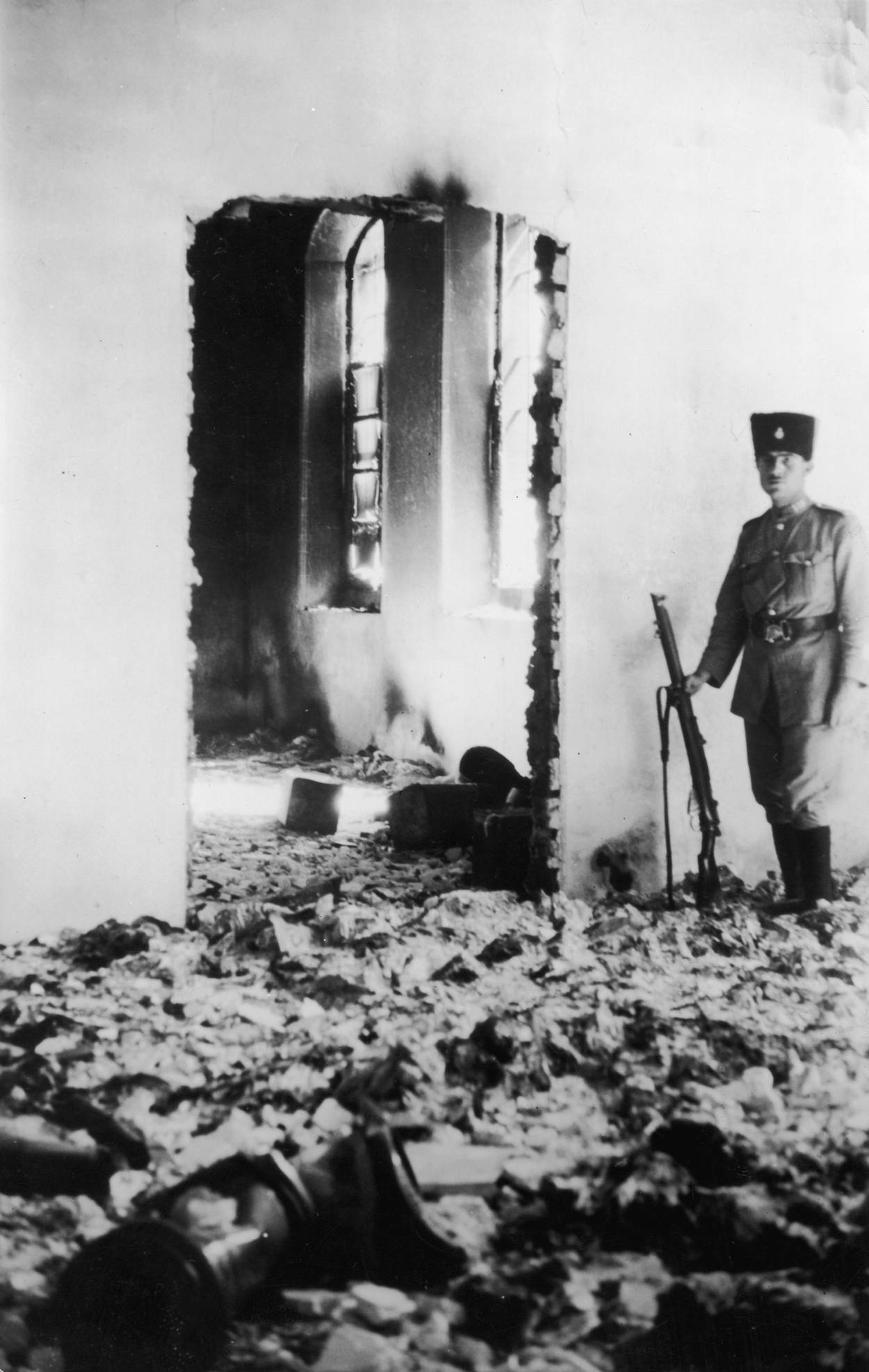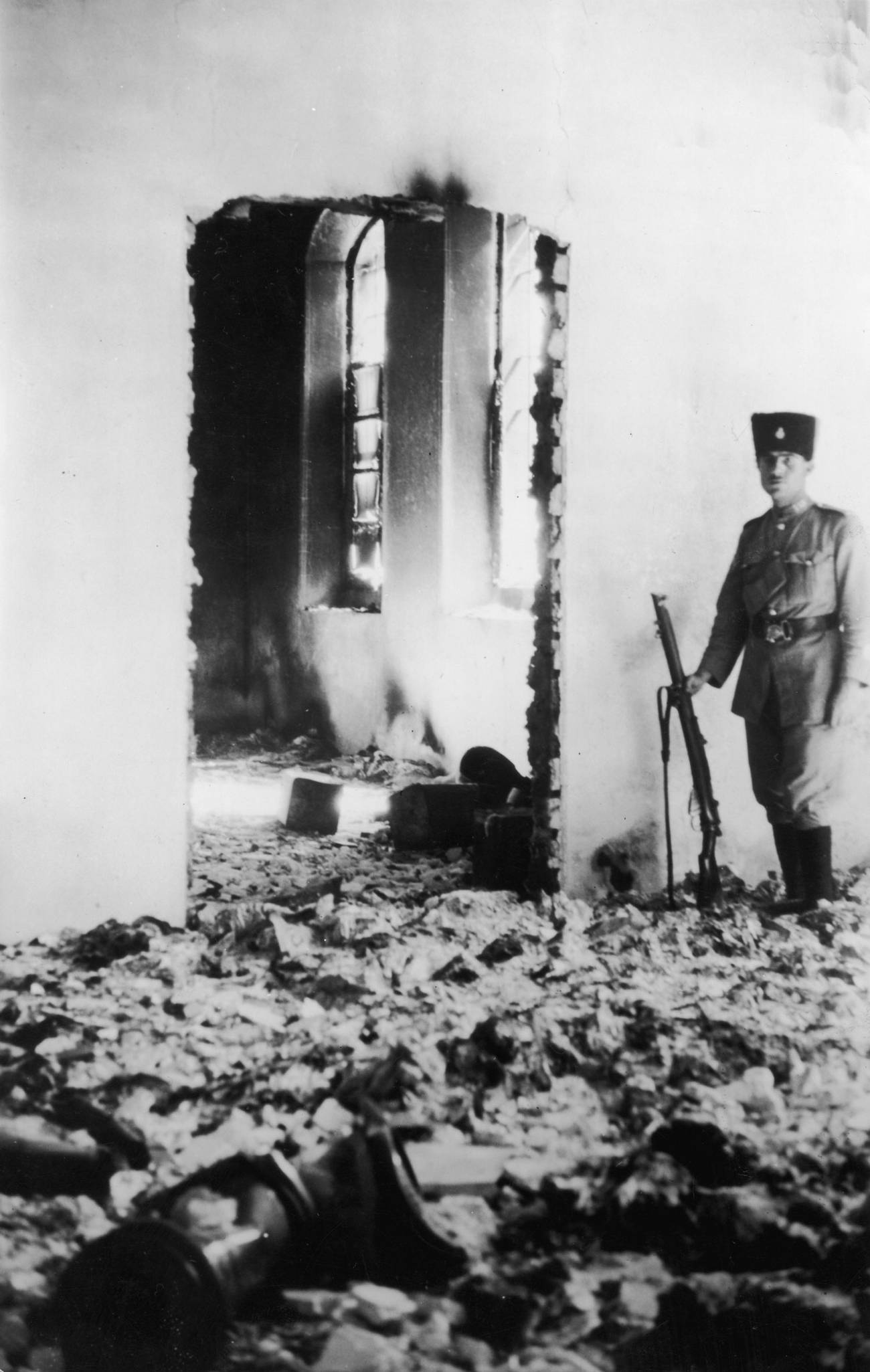In the days since Oct. 7, we have all grasped for words to describe the scale and brutality of Hamas’ massacre, comparing it to Israel’s 9/11 or the deadliest day for Jews since the Holocaust. Yet we need not look beyond the borders of Israel itself for a massacre of civilians much like the one we witnessed on that black Sabbath. Before the State of Israel was born, long before its military occupation began, Palestine was the scene of what was until now the most gruesome pogrom outside of Europe.
Early morning on Saturday, Aug. 24, 1929, some 3,000 Muslim men armed with swords, clubs, axes, and daggers went from Jewish house to Jewish house in the holy city of Hebron, stabbing, raping, and in some cases castrating and burning their victims alive. Jewish children watched as their parents were butchered by their Arab neighbors. Infants were killed in their mothers’ arms. Houses and synagogues were looted and torched. Sixty-seven unarmed Jewish men, women, and children were murdered that day.
One of the world’s most ancient Jewish communities, composed of some 800 people before the massacre, was decimated, along with centuries of coexistence that had made Hebron a model of peace between Jews and Muslims. In the aftermath of the attack, the British authorities that ruled Palestine forced the Jews of Hebron to evacuate, turning them into refugees.
Jews had lived in Hebron since biblical times, their lives centered around the Tomb of the Patriarchs, where Abraham and Sarah, Isaac and Rebecca, Jacob and Leah are believed to be buried. Much like the Jews who were killed on Oct. 7 were not settlers, the Jews killed in Hebron in 1929 were not Zionists. They did not need to be. They just needed to be Jewish.
The Hebron massacre of 1929 is not only ground zero of the Arab-Israeli conflict, but also a vital lesson for anyone who wishes to understand or resolve the existential war Israel is fighting.
When Israelis and Jews across the diaspora cry out that the war with Hamas is not about settlements, the blockade of Gaza, or the stalled peace process, it is 1929 that forms the bedrock of that conviction. In 1929, there was no Israeli oppression to rise up against. Then, as now, the blind rage directed at Jews rested on the refusal of Arab leaders to share this homeland of the Abrahamic faiths with the Jewish people. The line between 1929 and 2023 cuts through a century of Palestinian leaders’ refusal to accept a Palestinian state alongside a Jewish state. The similarities between these massacres and the causes behind them are a testament to how misunderstood this conflict is.
Before the State of Israel was born, long before its military occupation began, Palestine was the scene of what was until now the most gruesome pogrom outside of Europe.
The riots of 1929 were driven by a campaign of incitement and lies perpetuated by Grand Mufti Haj Amin Al-Husseini, the spiritual and political leader of Palestine’s Muslims under the British Mandate. Husseini had spent the year preceding the massacre galvanizing Islamic sentiment against Palestine’s Jewish minority. He fomented support for his cause by claiming that the Jews of Palestine sought to destroy Jerusalem’s Al-Aqsa Mosque to rebuild their ancient Temple, upon whose ruins Al-Aqsa was built. In sermons at Al-Aqsa the day before the massacre in Hebron, clerics called on the faithful to defend Al-Aqsa from the Jews. Armed worshippers flowed from the mosque and down to the Old City, where they attacked Jewish passersby and set fire to Jewish shops. Within hours, the riots spread throughout the country, killing 133 Jews across Palestine and wounding nearly 400 others.
The unarmed Jews of Hebron paid the heaviest price, suffering more casualties and more brutality than any other Jewish community in Palestine. Husseini, the father of Palestinian nationalism, would later flee Palestine and ally himself and his people with Adolf Hitler and the Nazi regime. During World War II, the mufti spread Nazi propaganda throughout the Arab world and recruited Muslims to fight for the Waffen SS.
The echoes of the Hebron massacre today illuminate how little has changed in a century of war between Abraham’s children. The perpetrators of both share not only the depravity displayed in their slaughter of men, women and children, but in their weaponization of Islam and their violent rejection of a shared future.
When the United Nations voted in 1947 to partition British Mandate Palestine into a Jewish state and an Arab state, Palestine could have been independent for the first time in history. After all, it had never been a sovereign state. Before the British took control of the territory in 1920, Palestine had been a province of the Ottoman Empire for nearly 500 years. Before that, it was ruled by a rotating cast of foreign powers, including the Crusaders, the Egyptians, the Romans, and the Greeks. While the U.N. Partition Plan was embraced by Palestine’s Jewish leaders, its Arab leaders and surrounding Arab states declared war and the mufti created the Holy War Army. The Nakba—the Palestinian catastrophe of 1948—was the result of that failed war.
The rejection of 1947 was echoed at the Camp David summit overseen by former President Bill Clinton in 2000. Israel offered the late Palestinian President Yasser Arafat a near-complete return to pre-1967 borders, a Palestinian state encompassing all of Gaza, 92% of the West Bank, and a capital in East Jerusalem. Arafat walked away from the negotiations, offering no alternative. The Second Intifada erupted two months later. Hamas’ suicide bombings and attacks on civilians were widely supported by Palestinians.
In 2005, absent peace negotiations, Israel unilaterally withdrew its forces from the Gaza Strip, forcibly evicting more than 9,000 of its own citizens in the hope that peace could take shape. The following year, Palestinians in Gaza elected Hamas, which had already been using the strip as a launch pad for rocket attacks against Israeli civilians. For Hamas, and for many Palestinians, all of Israel is an occupation. It is the only way to understand why the Palestinian leadership has over the past 75 years refused to accept a two-state solution, and why this violent resistance to Israel’s existence will not end until, in their own words, Palestine is free from the river to the sea.
When Israelis and Jews across the diaspora cry out that this war with Hamas is not about settlements, the blockade of Gaza, or the stalled peace process, it is 1929 that forms the bedrock of that conviction.
Hamas, the radical Islamist group that openly calls for Israel’s annihilation, is the spiritual heir of Grand Mufti Al-Husseini. Just as the mufti used The Protocols of the Elders of Zion to support his claim that the Jews of Palestine were planning to destroy Al-Aqsa, Hamas perpetuates those claims today. Hamas has long used the defense of Al-Aqsa as its calling card. Its self-proclaimed heroic operation on Oct. 7 was named “Al-Aqsa Flood.” Much like the rioters of 1929 praised Allah as they slaughtered men, women, and children, so too did Hamas fighters, in footage they uploaded to social media.
The language of Hamas’ leaders echoes the language of Al-Husseini, who invoked listeners on Radio Berlin in 1944 to “Kill the Jews wherever you find them. This pleases God, history, and religion.” Just as Hamas’ massacre was celebrated in the streets of Gaza and the West Bank, with Hamas falsely claiming that its victims were not civilians and that its gunmen had not murdered babies, the perpetrators of the massacre of 1929 are also celebrated as heroes by Palestinian leaders today. Then, as now, the atrocities committed in 1929 were either denied or blamed on their Jewish victims. And just as the expulsion of Jews from Hebron inspired the establishment of the early settlement movement, so too will Hamas’ massacre merely serve to harden an already skeptical Israeli public who have long believed there is no partner for peace.
Hamas would like the world to believe that its attack was about ending the blockade of Gaza—which they could have ended themselves had they abandoned their terror tactics and vows to destroy Israel—or about the stalled peace process, a process Hamas itself worked to derail with its waves of suicide bombings. For all of Israel’s flaws—and there are many—Zionist leaders have sought from the very beginning, before 1929, to share this tiny sliver of land with Abraham’s other children. There are many lessons in the parallels between the massacres of 1929 and 2023. The centurylong denial of the historic Jewish connection to the Land of Israel has made peace an impossible goal. After all, if Jews are indeed colonizers with no history in this land, why should Palestinians agree to share their homeland with this foreign nation? The notion that this war is about occupation is only true if one acknowledges that for Hamas, and for many Palestinians, the occupation is Israel itself. If there can be any hope for peace after this war, those who seek to achieve it must accept the difficult truths that both massacres make painfully clear.

